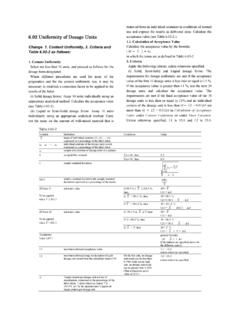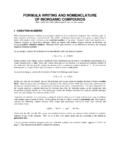Transcription of Bleached Starch (Tentative)
1 FAO/WHO 2016 Residue Monograph prepared by the meeting of the Joint FAO/WHO Expert Committee on Food Additives (JECFA), 82nd meeting 2016 Bleached Starch ( tentative ) This monograph was also published in: Compendium of Food Additive Specifications. Joint FAO/WHO Expert Committee on Food Additives (JECFA), 82nd meeting 2016. FAO JECFA Monographs 19 1 of 2 FAO/WHO 2016 Bleached Starch ( tentative ) Prepared at the 82nd JECFA (2016) and published in FAO JECFA Monograph 19 (2016), superseding specifications for Bleached Starch included in the specifications for Modified starches prepared at the 79th JECFA (2014), published in FAO JECFA Monographs 16 (2014).
2 An ADI not specified was established at the 26th JECFA (1982). Information is required on: Typical levels of residual reagents or byproducts SYNONYMS INS No. 1403 DEFINITION Starch is a carbohydrate polymer consisting of a large number of glucose units linked together primarily by alpha 1-4 glucosidic bonds. The Starch polymers come in two forms: linear (amylose) and branched through alpha 1-6 glucosidic bonds (amylopectin), with each glucose unit possessing a maximum of three hydroxyls that can undergo chemical substitution. Bleached Starch is a modified Starch . It is obtained by treatment of food Starch , in accordance with good manufacturing practice, with peracetic acid and/or hydrogen peroxide, or sodium hypochlorite or sodium chlorite, or sulfur dioxide or alternative permitted forms of sulfites, or potassium permanganate or ammonium persulfate.
3 The change is essentially in the colour only. Reagents are either removed or limited to technically unavoidable levels. Bleached Starch may additionally be subjected to acid, alkali or enzyme treatments in accordance with good manufacturing practices. number 977075-42-5 DESCRIPTION White or nearly white powder or granules or (if pregelatinized) flakes, or amorphous powder or coarse particles. FUNCTIONAL USES Thickener, stabilizer, binder, emulsifier CHARACTERISTICS IDENTIFICATION Solubility (Vol. 4) Insoluble in cold water (if not pre-gelatinized); forming typical colloidal solutions with viscous properties in hot water; insoluble in ethanol.
4 Microscopy Passes test See description under TESTS Iodine stain Passes test See description under TESTS 2 of 2 FAO/WHO 2016 Copper reduction Passes test See description under TESTS PURITY Loss on drying Cereal Starch : not more than Potato Starch : not more than Other starches: not more than (120 , 4 h, vacuum not exceeding 100 mm Hg) Sulfur dioxide (Vol. 4) Not more than 50 mg/kg on the dried basis for modified cereal starches Not more than 10 mg/kg on the dried basis for other modified starches Lead (Vol. 4) Manganese (Vol. 4) [Residual reagents] Carboxyl groups (Vol. 4) Not more than 2 mg/kg on the dried basis Determine using a method appropriate to the specified level.
5 The selection of sample size and method of sample preparation may be based on principles of methods described in Volume 4 (under General Methods, Metallic Impurities ). Not more than 50 mg/kg on the dried basis Determine using a method appropriate to the specified level. The selection of sample size and method of sample preparation may be based on principles of methods described in Volume 4 (under General Methods, Metallic Impurities ). Information required Not more than on the dried basis TESTS IDENTIFICATION TESTS Microscopy Modified starches which have not been pre-gelatinized retain their granular structure and can be identified as starches by microscopic observation.
6 Shape, size and sometimes striations are characteristics of the botanical origin. In polarized light under cross nicol prisms the typical polarization cross will be observed Iodine stain Add a few drops of N potassium tri-iodide to an aqueous suspension of the sample. These starches stain with iodine in the same way as native starches. The colour can range from dark blue to red Copper reduction Place about g of the sample previously washed with water, in a boiling flask, add 10 ml of dilute hydrochloric acid (3%) and 70 ml of water, mix, reflux for about three hours and cool. Add ml of the resulting solution to 5 ml of hot alkaline cupric tartrate TS.
7 A copious red precipitate is produced
















